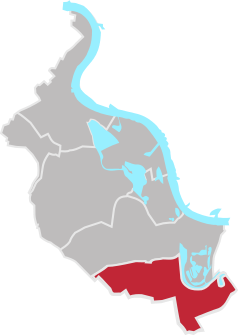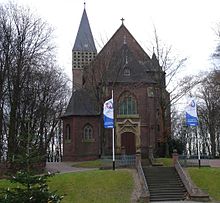Birten
|
Birten
City of Xanten
|
|
|---|---|
| Coordinates: 51 ° 38 ′ 11 " N , 6 ° 28 ′ 27" E | |
| Height : | 31 m |
| Area : | 10.75 km² |
| Residents : | 1776 (Dec 31, 2004) |
| Population density : | 165 inhabitants / km² |
| Incorporation : | 1st July 1969 |
| Postal code : | 46509 |
| Primaries : | 02801, 02802 |
|
Location of Birten in Xanten
|
|
Birten is the south-eastern district of Xantens .
geography
Birten is located a few kilometers southeast of Xanten and is divided into the two districts of Oberbirten and Unterbirten, which are separated from each other by the federal highway 57 . Oberbirten is located at the foot of the Fürstenberg amidst deciduous and coniferous forest , while Unterbirten on the Old Rhine is in the immediate vicinity of the Bislicher Insel nature reserve .
history
The first evidence of human life in today's local area are axes from the Neolithic Age.
Antiquity
Around 15 BC The Roman legionary camp Vetera was founded on the Fürstenberg near today's Birten. At that time, the area surrounding the camp consisted mainly of swamp and moorland , which, in connection with the elevated position of the Fürstenberg, represented a strategic advantage. The camp was supposed to serve as a starting point for campaigns in the Germania on the right bank of the Rhine ( legions involved in the Varus Battle were also stationed here) and was permanently occupied by 8,000 to 10,000 legionnaires until it was destroyed during the Batav rebellion in 70 AD . After the destruction of Vetera, a new legion camp was built not far from them on Bislicher Island, which continued the name Vetera.
Both camps are no longer preserved today. There is only the Erdwalltheater of Vetera I that than it is today open-air stage for orchestra or comedians is used. Here should also be in the 4th century Viktor of Xanten as a member of the Theban Legion , the martyrdom suffered.
middle Ages
The area of today's Birtens was first settled in the 5th century after the fall of the Western Roman Empire , when Franks settled away from the former Roman settlements. This first settlement was called "Bertunense", later also "Beurtina" or "Bertuna" and in the 11th century "Birthine". The current place name Birten developed from this. A first documentary mention of Birtens comes from Bishop Gregory of Tours . This reports about Bishop Everigisil of Cologne, who around 590 AD had a chapel near Bertunense expanded into a church . Since this church in Birten cannot be proven archaeologically, it seems likely that it was erected above the cemetery of Colonia Ulpia Traiana and thus in today's Xanten, where such a structure could be proven as early as the 4th century.
In the year 863, Normans attacked the Xanten church monastery and looted Birten, which at that time had already developed into a market. In 880 Normans attacked the place again and burned it down completely. In 939 Birten was the scene of a battle that, in connection with the Battle of Andernach, sealed the Rhineland's membership of the empire of Otto the Great .
In a document from 1161 the anti-pope confirmed Viktor IV. Of Deutz Abbey their possessions. "Birtine" was mentioned in the list.
At the end of the 14th century the knight's seat Winnenthal , today one of the oldest preserved moated castles in the Lower Rhine , was built near today's Birten . Today it serves as a retirement home .
In 1557 and again at the end of the Thirty Years' War and in 1764 the river bed of the Rhine shifted , so that large parts of Birtens were either submerged or flooded and finally abandoned. The residents of Birtens founded new settlements not far to the southwest in the higher-lying area at the foot of the Fürstenberg.
Modern times
After Birten had already been abandoned three times from 1557 to 1764 due to the relocation of the Rhine bed, the fourth settlement was given "protection" from further floods for the first time in 1788 when a new bed was built for the Rhine through a canal on Bislicher Island. The village's fifth church was completed in 1767 , with St. Viktor replacing St. Peter, whose name the Birten churches had previously borne , as patron saint . As early as 1905, at that time around 1,000 people lived in Birten, a new church was inaugurated as the previous church building no longer offered enough space for all of Birten's residents. This church, also called St. Viktor, was set on fire at the end of the Second World War by the defending paratroopers of the Wehrmacht before the town was handed over to Allied troops and the church tower was blown up, although it had been spared from aerial bombs so far. During the war there was a munitions factory in Birten .
On April 1, 1939, the municipality of Winnenthal was incorporated into Birten. In the course of the municipal reorganization, the municipality of Birten, which had been part of the Alpen-Veen office until then , was incorporated into the city of Xanten on July 1, 1969 .
coat of arms
Blazon: in red an eight-pointed golden (yellow) lily reel; above it a silver (white) key with the beard on the top right. The coat of arms was approved by the district president in Düsseldorf on December 11, 1962.
Meaning: The coat of arms is based on an old seal from Birtens from the 15th century. The lily reel stands for belonging to the Duchy of Cleves and the key reminds of St. St. Peter, the patron saint of the place.
Attractions
- The Church of St. Viktor
- Winnenthal Castle , the oldest moated castle on the Lower Rhine
- Amphitheater Birten, an open-air stage for orchestras or comedians
traffic
Birten had a stop on the Rheinhausen – Kleve railway line and a train station on the Boxtel – Büderich railway line . The former route is still used to Xanten, but the trains pass Birten without stopping; the latter route, however, has been closed .
Web links
- Entry on the Roman amphitheater in Birten in the " KuLaDig " database of the Rhineland Regional Council
literature
- Ingo Runde: Bertuna, Beurtina, Biorzuna, Bierzuni, Biertana, Birten. Problems of identification and localization in the early and high Middle Ages, in: Caelius and after? History and future of the Fürstenberg and Bislicher Insel at Xanten Table Ronde in Xanten from 18. – 19. June 2009 (= materials for the preservation of monuments in the Rhineland 23), ed. by Jürgen Kunow, Treis-Karden 2011, pp. 133–144.
- Ingo Runde: Ranges, Rivers and Roads. On the function and importance of topographical aspects in border conflicts in the early and high medieval Xanten area. With an excursus on references between the Gereons Chapel in Xanten “in the marshes” and the “Battle of Birten” in 939 AD. In: Rheinische Vierteljahrsblätter 77, 2013, pp. 25–58.
- Arno Knauf, Willi Theußen and Theo Zumkley: Oppidum Bertunense - Beurtina - Biorzuna - Bierzuni - Biertona - Birthine - Birten. Contributions to the history of the village, in: Studies on the history of the city of Xanten 1228–1978, ed. von der Stadt Xanten, 2nd edition Cologne 1983, pp. 265–278.
- Hans Scheller: Birten on the run from the Rhine, in: Home calendar for the district of Moers 1963, pp. 87-92.
- Harald von Petrikovits: Birten, in: Niederrheinisches Jahrbuch 3, 1951, pp. 37-44.
Individual evidence
- ^ In: Annals of the Historical Association for the Lower Rhine . 2nd issue, 1855, p. [127] 237.
- ↑ Cf. Matthias Becher : Otto the Great. Emperor and Empire. A biography. Beck, Munich 2012, ISBN 978-3-406-63061-3 , p. 132 f.
- ↑ Lacomblet, Theodor Joseph, in: Document book for the history of the Lower Rhine or the Archbishopric of Cologne, certificate no. 449 . Volume 4, 1858, pp. [804] 778. Digitized edition ULB Bonn
- ^ Official journal for the administrative district of Düsseldorf 1938, p. 209
- ↑ Martin Bünermann: The communities of the first reorganization program in North Rhine-Westphalia . Deutscher Gemeindeverlag, Cologne 1970, p. 103 .
- ↑ [1] Description of the coat of arms "Heraldry of the World"





